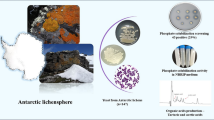Abstract
We investigated the potential production and desiccation tolerance of microsclerotia (MS) by Brazilian strains of Metarhizium anisopliae (Ma), M. acridum (Mc) and M. robertsii (Mr). These fungi were grown in a liquid medium containing 16 g carbon l−1 with a carbon:nitrogen ratio of 50:1. One hundred milliliters cultures were grown in 250 ml Erlenmeyer flasks in a rotary incubator shaker at 28 °C and 200 rpm for 5 days. Five-day-old MS were harvested, mixed with diatomaceous earth (DE) and air-dried for 2 days at 30 °C. The air-dried MS–DE granular preparations were milled by mortar + pestle and stored in centrifuged tubes at either 26 or −20 °C. Desiccation tolerance and conidia production were assessed for dried MS granules by measuring hyphal germination after incubation for 2 days on water agar plates at 26 °C and for conidia production following 7 days incubation. Yields of MS by all strains of Metarhizium were 6.1–7.3 × 106 l−1 after 3 days growth with maximum MS yields (0.7–1.1 × 107 l−1) after 5 days growth. No differences in biomass accumulation were observed after 3 days growth, whereas Ma-CG168 showed the highest biomass accumulation after 5 days growth. Dried MS–DE preparations of all fungal strains were equally tolerant to desiccation (≥93 % germination) and the highest conidia production was obtained by MS granules of Mc-CG423 (4 × 109 conidia g−1). All MS granules showed similar stability after storage at either 26 or −20 °C for 3.5 months.




Similar content being viewed by others
References
Behle RW, Jackson MA, Flor-Weiler L (2013) Efficacy of a granular formulation containing Metarhizium brunneum F52 (Hypocreales: Clavicipitaceae) microsclerotia against nymphs of the black-legged tick, Ixodes scapularis Say (Acari: Ixoididae). J Econ Entomol 106(1):57–63
Bischoff JF, Rehner SA, Humber RA (2009) A multilocus phylogeny of the Metarhizium anisopliae lineage. Mycologia 101:508–528
Connick WJ Jr, Daigle DJ, Boyette CD, Williams KS, Vinyard BT, Quimby PC Jr (1996) Water activity and other factors that affect the viability of Colletotrichum truncatum conidia in wheat flour-kaolin granules (‘Pesta’). Biocontrol Sci Tech 6:277–284
Faria MR, Wraight SP (2007) Mycoinsecticides and Mycoacaricides: a comprehensive list with worldwide coverage and international classification of formulation types. Biol Control 43:237–256
Faria M, Hotchkiss JH, Wraight SP (2011) Application of modified atmosphere packaging (gas flushing and active packaging) for extending the shelf life of Beauveria bassiana conidia at high temperatures. Biol Control 61:78–88
Hong TD, Jenkins NE, Ellis RH, Moore D (1998) Limits to the negative logarithmic relationship between moisture content and longevity in conidia of Metarhizium flavoviride. Ann Bot 81:625–630
Jackson MA, Jaronski ST (2009) Production of microsclerotia of the fungal entomopathogen Metarhizium anisopliae and their potential for use as a biocontrol agent for soil-inhabiting insects. Mycol Res 113(8):842–850
Jackson MA, Jaronski ST (2012) Development of pilot-scale fermentation and stabilisation processes for the production of microsclerotia of the entomopathogenic fungus Metarhizium brunneum strain F52. Biocontrol Sci Tech 22(8):915–930
Jackson MA, Schisler DA (1995) Liquid culture production of microsclerotia of Colletotrichum truncatum for use as bioherbicidal propagules. Mycol Res 99:879–884
Jackson MA, McGuire MR, Lacey LA, Wraight SP (1997) Liquid culture production of desiccation tolerant blastospores of the bioinsecticidal fungus Paecilomyces fumosoroseus. Mycol Res 101:35–41
Jaronski ST (2007) Soil ecology of the entomopathogenic ascomycetes: a critical examination of what we (think) we know. In: Maniana K, Ekesi S (eds) Use of entomopathogenic fungi in biological pest management. Research Sign Posts, Trivandrum, India, pp 91–143
Jaronski ST, Jackson MA (2008) Efficacy of Metarhizium anisopliae microsclerotial granules. Biocontrol Sci Tech 18:849–863
Li Z, Alves SB, Roberts DW, Fan M, Delalibera I Jr, Tang J, Lopes RB, Faria M, Rangel DEN (2010) Biological control of insects in Brazil and China: history, current programs and reasons for their successes using entomopathogenic fungi. Biocontrol Sci Tech 20:117–136
Lomer CJ, Bateman RP, Johnson DL, Langewald J, Thomas M (2001) Biological control of locusts and grasshoppers. Annu Rev Entomol 46:667–702
Mugnier J, Jung G (1985) Survival of bacteria and fungi in relation to water activity and the solvent properties of water in biopolymer gels. Appl Environ Microbiol 50:108–114
Roberts DW, St. Leger RJ (2004) Metarhizium spp., cosmopolitan insect-pathogenic fungi: mycological aspects. Adv Appl Microbiol 54:1–70
Sasan RK, Bidochka MJ (2012) The insect-pathogenic fungus Metarhizium robertsii (Clavicipitaceae) is also an endophyte that stimulates plant root development. Am J Bot 99(1):101–107
Shearer JF, Jackson MA (2006) Liquid culturing of microsclerotia of Mycoleptodiscus terrestris, a potential biological control agent for the management of Hydrilla. Biol Control 38:298–306
Statistical Analysis Systems (SAS) (2008) SAS/STAT®, release 9.2 User’s Guide. SAS Institute, Inc., Cary, NC, USA
Stowell LJ (1991) Submerged fermentation of biological herbicides. In: TeBeest DO (ed) Microbial control of weeds. Chapman and Hall, New York, USA, pp 225–261
Wang S, Fang W, Wang C, St. Leger RJ (2011) Insertion of an esterase gene into a specific locust pathogen (Metarhizium acridum) enables it to infect caterpillars. PLoS Pathol 7(6):e1002097
Zimmermann G (2007) Review on safety of the entomopathogenic fungus Metarhizium anisopliae. Biocontrol Sci Tech 17(9):879–920
Acknowledgments
This work was funded by Embrapa (Empresa de Pesquisa Brasileria de Agropecuária, Brasília, Brazil). We thank Rogério B. Lopes and Marcos R. Faria (Embrapa Cenargen) for providing the strains of Metarhizium spp. and for measuring water activities.
Author information
Authors and Affiliations
Corresponding author
Additional information
Mention of trade names or commercial products in this article is solely for the purpose of providing specific information and does not imply recommendation or endorsement by Embrapa or by USDA.
Rights and permissions
About this article
Cite this article
Mascarin, G.M., Kobori, N.N., de Jesus Vital, R.C. et al. Production of microsclerotia by Brazilian strains of Metarhizium spp. using submerged liquid culture fermentation. World J Microbiol Biotechnol 30, 1583–1590 (2014). https://doi.org/10.1007/s11274-013-1581-0
Received:
Accepted:
Published:
Issue Date:
DOI: https://doi.org/10.1007/s11274-013-1581-0




